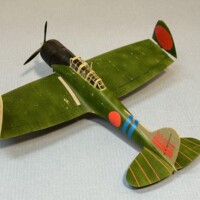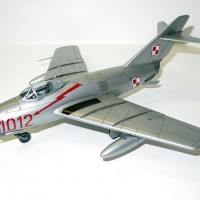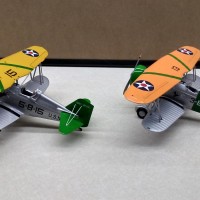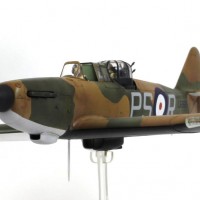1/72 Aichi Type 99 “Val” Dive Bomber
Next in my trio of 1/72 1941-42 IJN aircraft was an Aichi Type 99 "Val" dive bomber. The kit was the 2011 Dragon/Cyberhobby, which contains markings for seven Pearl Harbor aircraft (two from Akagi).
While the kit itself is good, the instructions are poor. Parts are routinely mislabeled, and the drawings provide insufficient information regarding placement. It has separate canopy parts which might look good for an open canopy build, but since there is no machine gun provided, the aft part of the canopy really can't be built open.
My first IJN build, a Zero in plain "Ame-iro" finish (while technically I think the referenced finish may be the result of the varnish applied over the J3 gray, from a modeler's perspective I'm just referring to the basic gray-green paint color) kind of burned me out on solid "white" aircraft. And I was really intrigued by the finish of BII-213 piloted by PO Toshikatsu Nishimura with Lt. Shun Nakagawa in the rear seat, commanding the Hiryu's Val force at Pearl Harbor as illustrated by Rock Roszak in Bert Kinzey's Attack on Pearl Harbor: Japan Awakens a Sleeping Giant: Expanded Digital Edition.
Kinzey first notes that the Vals of the Second Carrier Division (Hiryu and Soryu) had a greenish-khaki color, which allowed me to get away from the Ame-iro I had used for the Zero, which was contaminated with some small black debris. I used instead Vallejo 71.311 IJN Ash Grey. For the interior, I used the same 71.137 US Light Green FS 34151, which was a little darker than the interior green I use for US aircraft, and Tamiya X-13 Metallic Blue for the "aotake" on the exposed wing folds.
BII-213 is represented in the book as having a dark green overspray, unlike most of the rest of the attacking Vals at Pearl Harbor, and while I could never confirm that the color was on the wings and horizontal stabilizers as it would be later for many Japanese carrier aircraft, I made the assumption that it was. Some of the aircraft were known to have had the fuselages only painted in bright colors as an aid form reforming plans after an attack, but dark green seemed to be more for camouflage purposes. I used Vallejo 71.322 IJN Black Green. Applied in the incomplete manner shown in the painting the green appeared too light initially, but it reads much darker after the red roundels are applied.
The cowling is the same FS 15042 over black primer as the Zero.
I applied a "chipping medium" between the overall IJN Ash Gray and the Black Green and lightly chipped the finish. While the greenish overspray would be dramatically chipped by February, possibly due to an adhesion problem with the overspray, my assumption was that at Pearl Harbor the overspray would still be in good condition.









A very nice result, Michael @mcsmith1964
Especially considering the tiny scale and the lack of decent instructions, you clearly got the best out of it.
Great result, Michael!
A nice-looking build! I'm a big fan of Japanese aircraft, especially in 1/72.
Looks very very good! I try to find this kit few years ago but finally only build Fujimi kit (which, despite its simplicity, turned out to be completely pleasant in terms of construction and the end result.)